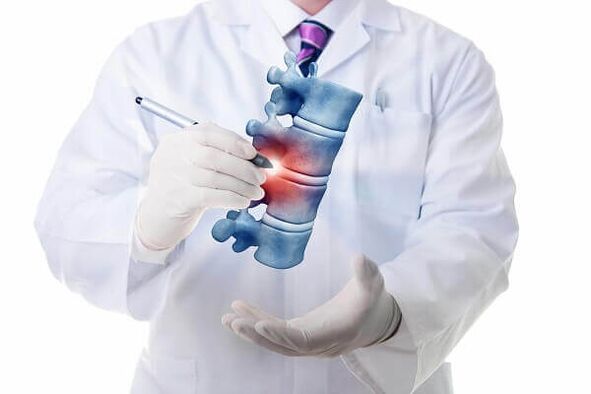Osteochondrosis of the spine is a degenerative disease that manifests itself in the destruction of cartilage and bone tissue. The pathology is chronic and occurs with frequent relapses. First, it affects the intervertebral disc, then other structures of the axial column and the central nervous system.

Initially, osteochondrosis of the spine was considered a disease of older people, but recently the pathology has become much younger. Today, degenerative changes are often diagnosed in people aged 23 to 45.
Causes
A single cause of osteochondrosis has not been established. Doctors of ancient practice believed that the disease develops against the background of the deposition of calcium salts that are not completely absorbed by bone tissue. Today, other versions of the occurrence of dystrophic destruction of the spine have been proposed.
The main ones are:
- back injuries;
- heredity;
- flat feet, congenital clubfoot;
- obesity;
- sedentary work, passive lifestyle;
- metabolic disorder;
- bad position;
- asthenic body type, natural weakness of muscles and ligaments;
- harmful working conditions (vibrations, shaking, body tremors);
- frequent lifting of heavy objects;
- hypothermia;
- stress;
- chronic inflammation of tissues of an infectious nature.
For the fairer sex, uncomfortable high-heeled shoes can be a provoking factor. Frequent pregnancies also contribute to the development of spinal injuries.
Symptoms
The degenerative destruction that occurs in the body of the intervertebral disc leads to loss of elasticity, prevents the accumulation and release of fluid, and worsens the shock-absorbing properties of the axial spine.
As a result, the load on the annulus fibrosus increases, it becomes thinner and cracks, and the vertebrae come dangerously close to each other. Pathological compression of bone structures and cartilage develops.
The severe pain that occurs is accompanied by the following symptoms of osteochondrosis of the spine:
- numbness, goose bumps, burning sensation in the affected area;
- reduced mobility;
- back muscle fatigue;
- reduced performance, fatigue.
The considered signs of osteochondrosis are general. The specific symptoms of the disease depend on which segment of the spine was destroyed.
With compression of the cervical spine, blood flow in the vessels deteriorates, which leads to frequent migraines, dizziness and loss of consciousness. The patient may complain of tinnitus, spots before the eyes, pain in the shoulders and arms.
Structural destruction of the lower back forces a person to adopt a forced posture, standing up and sitting down slowly. The pain appears in the buttock, radiating down the limb to the lower leg and foot. Intermittent claudication develops.
Most symptoms of spinal osteochondrosis belong to the vertebral type. Disorders that form outside the axial spine are called extravertebral syndrome. For example, vascular disorders of the brain caused by compression of the vertebral artery.
Types
Osteochondrosis of the back is classified according to the place of its occurrence - cervical, thoracic and lumbosacral. More than half of cases occur in the lumbar spine, a third of all diagnoses concern the cervical segment.
Which doctor treats osteochondrosis?
If you experience severe back pain, you should postpone your appointment with a neurologist or neurologist. If such specialists are not available at your local clinic, you should contact your GP. After the first examination, the doctor will prescribe treatment or refer you to other specialists.
Diagnostic
The diagnosis of osteochondrosis begins with an interview with the patient. The doctor is interested in the time of onset of symptoms, the intensity and nature of the pain, as well as its location. Then the specialist begins visual inspection and palpation of the spine.

Due to the variety of symptoms, an obligatory element in the diagnosis of osteochondrosis is the use of instrumental studies:
- X-ray of the entire spine in 2 projections;
- MRI and CT scans;
- Dopplerography of the vessels and arteries of the cervical spine.
Unfortunately, X-rays do not provide a complete picture of the condition of the soft structures of the spine: the spinal roots and disc tissue are not examined. In this case, functional MRI comes to the rescue, which differs from classic MRI in the localization of the patient's body.
Treatment
How to treat osteochondrosis of the spine? To combat the disease, conservative and surgical treatment is used. The main goal of both techniques is to eliminate pain and prevent further destruction of bone tissue and cartilage.
Non-operative treatment of osteochondrosis of the back includes:
- massage;
- exercise therapy;
- traction of the entire spine;
- manipulative therapy;
- impact on active points.
The effectiveness of the methods largely depends on the patient's perseverance and the systematic nature of the manipulations.
The intensive period of therapy lasts 2-2. 5 months. At the beginning of the course, an increase in pain and discomfort in the back area is possible.
Surgical treatment of spinal osteochondrosis is prescribed when a conservative approach is ineffective. A surgical indication is compression of the intervertebral space by one third of the initial distance. The main method of intervention for osteochondrosis is discectomy - partial or radical removal of the affected disc.
After spinal surgery, the patient requires rehabilitation for at least six months. During this period, the patient is recommended to visit sanatoriums, undergo a course of mineral baths, physiotherapy and massage.
Unfortunately, it is impossible to completely cure osteochondrosis of the spine. Degenerative changes in bones and soft tissues are irreversible and manifest chronically. The process of destruction can only be slowed down and its inherent symptoms alleviated.
Complications
Complications of spinal osteochondrosis often form as a result of compression of the spinal cord and feeding arteries. Against this background, the patient develops discogenic myelopathy, limb paresis, impaired reflexes and sphincter dysfunction. A herniated disc can cause a spinal cord infarction.
Damage to the cervical spine leads to hearing loss, blurred vision and constant migraines. The patient develops memory problems and a reduction in learning ability.
If osteochondrosis is not treated for a long time, serious damage to the pelvis and legs, paralysis of the limbs and intermittent claudication may develop. In women, long-term spinal dystrophy often leads to infertility, while in men a decrease in potency is typical.
Prevention

No one is immune from a disease like osteochondrosis. In old age, the disease affects almost everyone. To prevent dystrophic changes, it is necessary to take care of the spine from an early age.
Moderate sports activity, a balanced diet with a sufficient amount of vitamins, a healthy lifestyle - all this will help you stay healthy for many years.
Prevention of spinal osteochondrosis includes more specific measures:
- avoid stress;
- timely treatment of infections and pathologies of the musculoskeletal system;
- limit the weight of objects to be lifted;
- strengthen the immune system.
Women can be advised to choose the right shoes and monitor the appearance of foot valgus.
The development of osteochondrosis of the spine can significantly complicate the patient's life. Only long-term systemic treatment will help eliminate severe symptoms. The main thing is not to despair and fight for your health.






















